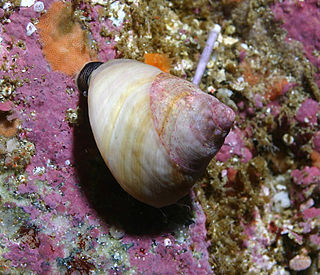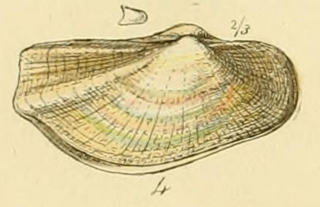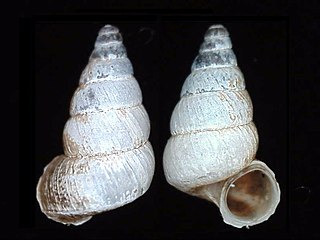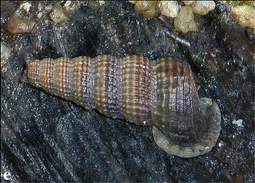
Tegula is a genus of small to medium-sized sea snails, marine gastropod molluscs in the family Tegulidae.

Atlanta is a genus of pelagic marine gastropod molluscs in the family Atlantidae. They are sometimes called heteropods.

Lyonsiidae is a family of small saltwater clams, marine bivalve molluscs in the order Anomalodesmata.

Verticordiidae is a family of benthic marine bivalves in the superorder Anomalodesmata. These clams range from 2 - 200 millimeters in length and are mainly found in coastal waters surrounding Australia and the Americas, though a few species within this family such as Haliris mediopacifica are found in the middle of the ocean. Verticordiidae is known for being a family of septibranchs, or predatory bivalves, rather than filter feeders. Clams dig vertical burrows in substrate and use papillae around the edges of their inhalant siphons to detect microscopic prey. Some clams in this family, specifically in the genus Trigonulina, have distinct extended circular formations on their shells.

Liarea is a genus of land snails with an operculum, terrestrial gastropod molluscs in the subfamily Liareinae.
Pseudolividae is a taxonomic family of medium-sized sea snails, marine gastropod mollusks in the superfamily Olivoidea.

Cerithidea is a genus of medium-sized sea snails or mud snails, marine gastropod mollusks in the family Potamididae, the horn snails.

Pyramidella is a genus of minute to medium-sized sea snails, marine gastropod mollusc in the subfamily Pyramidellinae of the family Pyramidellidae, the pyrams and their allies.

Acteocina is a genus of very small sea snails, bubble snails, marine opisthobranch gastropod mollusks in the family Tornatinidae, the canoe bubbles or chalice bubble snails.
Haliris is a genus of the class Bivalvia of the family Verticordiidae.
Actinopora is a genus of bryozoans belonging to the family Plumatellidae.
HalicardiaDall, 1895 is a genus of bivalves in the family Verticordiidae.
Vertambitus is a genus of the bivalves in the family Verticordiidae.
Simplicicordia is a genus of small carnivorous bivalves in the family Verticordiidae. It contains the single species S. trigonata.
Vertisphaera is a genus of small carnivorous bivalves in the family Verticordiidae. It contains the single species V. cambrica.
Trigonulina novemcostata is a carnivorous bivalve in the family Verticordiidae. It is native to the South China Sea with 7–8 prominent ribs on its surface and ranges from about 0.7-5 millimeters in size in accordance with the unaccepted genus Hippagus it was originally described as. It is the only currently known species in the genus Trigonulina that lives outside of the western Atlantic Ocean, being found in the South China Sea and Pacific Ocean. This species has been observed between California and Peru as well as in Costa Rica. Malacologists currently debate if T. novemcostata is a separate species or a variant of T. ornata due to their similar appearances and habitat overlap.
Trigonulina ornata, commonly known as the "'Ornate verticord", is a carnivorous bivalve in the family Verticordiidae. It is native to coastal waters throughout the western Atlantic Ocean at depths of 18-850 meters below the surface. It has 8-11 prominent ribs on its surface and can be a maximum of 5.6 millimeters in size, though on average ranges from 1-3.6 millimeters.







